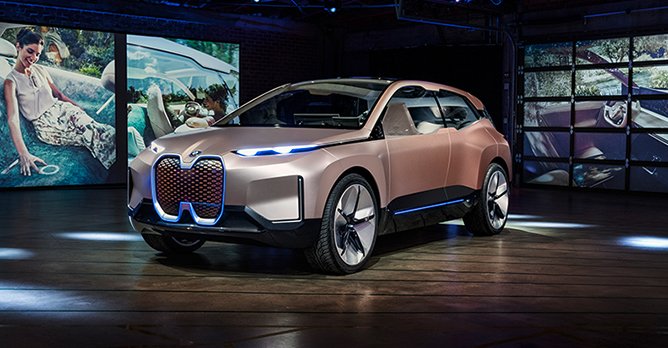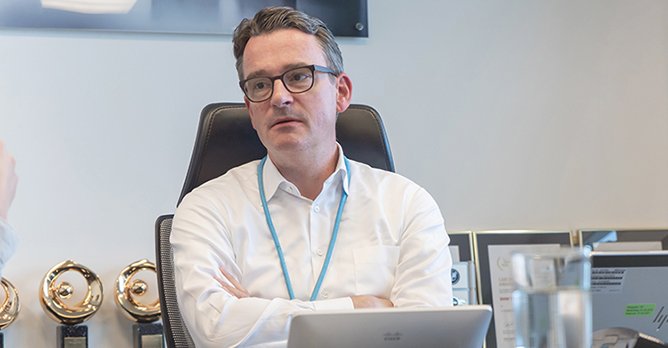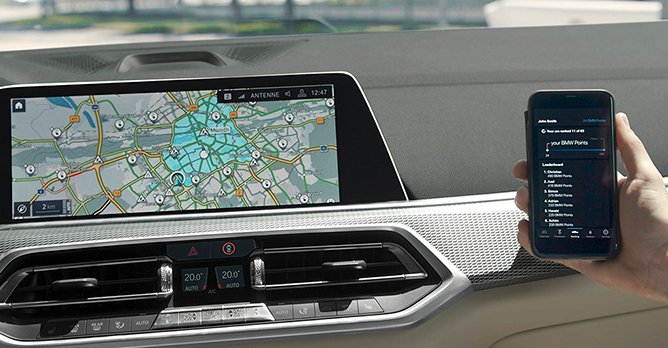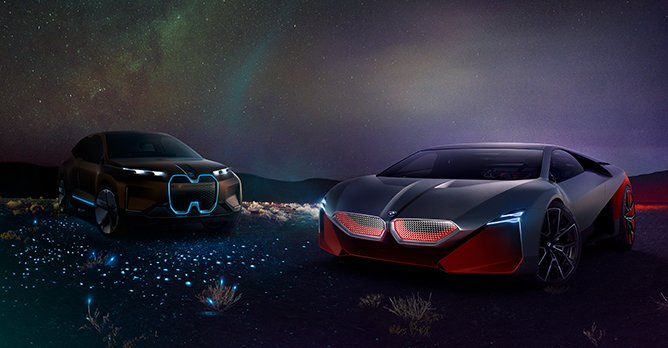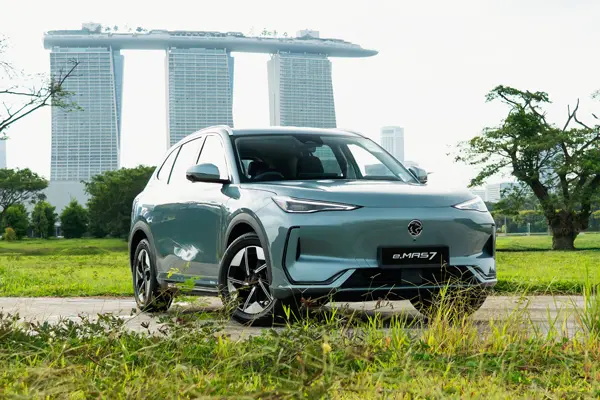Sustainability, e-mobility and BMW's vision of the future
12 Jul 2019|10,755 views
The BMW Vision iNEXT, unveiled last year, gave us a glimpse of what BMW envisions the future to look like. Except, of course, that future isn't quite that far away. The production version of the iNEXT is set to be launched in 2021, and with it comes a whole host of new technologies - Level 3 autonomous driving on highways at up to 130km/h, Level 5 connectivity that will come with a whole range of new services BMW will offer, as well as new and innovative ways for us to interact with the car.
The iNEXT is important for BMW. As Dr. Andrea Aumann, Vice President Product Management BMW i, eMobility, BMW AG, tells us, "It epitomises BMW's Strategy NUMBER ONE > NEXT, and focuses very much on D+ACES: Design, Autonomous driving, Connectivity, Electrification, and Services. The iNEXT is the car that brings everything together. It is going to be a future-oriented product, at the same time the iNEXT is the car in which we bring quite a few of these innovations into our series production models."
Of course, BMW's vision of the future extends beyond just delivering ground-breaking new products and technologies. A key responsibility is to further the transition toward e-mobility, and the adoption of electrified vehicles in the forms of full-electric vehicles (EVs) and plug-in hybrids models (PHEVs). In this, BMW i has a key role to play, with plans to have a total of 25 electrified vehicles by 2023 (two years earlier than previously announced).

However, there are also emotional factors. "An electric car delivers new emotions and driving experiences, such as new ways of interacting with the car, silent driving and instant torque. What we can do as the OEM is to provide attractive and emotional products."
PHEVs are a good segue into e-mobility, according to Dr. Aumann, because of the low infrastructure requirement. "PHEVs can be charged with a wall plug at work and at home. With 50km-75km of all electric range, that's above the typical average daily driving distance. So when ideally used, you can conduct the majority of your daily drive fully electric. You have all the benefits of electric driving, but you still have the gasoline engine that makes you independent of electrical infrastructure. It's very likely that in many cases, the PHEV is the viable solution for the customer first."
The transition to e-mobility solution represents a steep transformation for the automotive industry, something that brands are increasingly undertaking together. BMW and Jaguar Land Rover have announced a partnership to jointly develop future evolutions of the electric drivetrain, while BMW and Daimler have also inked an agreement to jointly develop autonomous technology.
With shared costs of development and production planning, as well as economies of scale in the procurement market, it makes sense for brands to cooperate in order to shoulder costs together and manage this transformation, while of course still achieving the target of remaining profitable.
"At the same time, the auto industry will continue to be an industry with hyper competition, so brand identity is a key factor here. We will collaborate in areas where it makes sense, but also maintain our brand identity with regards to the specific technologies developed. That’s important," Dr. Aumann adds.
BMW and Daimler are also jointly investing in new mobility services, comprising of five ventures - Reach Now, Charge Now, Free Now, Park Now and Share Now. The brands share a common vision - these services will converge into a single mobility service portfolio that addresses the needs of more than 60 million customers worldwide, Dr. Aumann highlights.
Of course, sustainability extends beyond just the automotive product and the end user. Since the launch of the i3 in 2013, BMW has been committed to ensuring the sustainability of the entire process. Carbon fibre production was moved to the Moses Lake plant in the U.S.A so that this energy intensive step was undertaken with 100% green hyrdrogen power.
The brand's European assembly plants are now all operating on green energy, and there are plans to expand this globally, according to Dr. Aumann. BMW and its suppliers have also agreed on a sustainability code.
The brand also continues to ensure that its sustainability strategy moves forward, such as the reduce usage of rare earths. The 5th generation electric drivetrain, which will come to market in the iX3, will have a motor without rare earths. "Sustainability has always been connected with e-mobility at BMW," says Dr. Aumann.
BMW's strategy for the future is vast, ambitious, and necessary. With significant investment and development in new technologies, both automotive and beyond, it's clear that the brand is broadening its scope of operations. Concepts such as the Vision iNEXT and Vision M NEXT posit a new and better future, while the continued development of PHEVs and EVs reveal an actualised roadmap for reaching that new future.
And remember, that future isn't quite that far away.
The BMW Vision iNEXT, unveiled last year, gave us a glimpse of what BMW envisions the future to look like. Except, of course, that future isn't quite that far away. The production version of the iNEXT is set to be launched in 2021, and with it comes a whole host of new technologies - Level 3 autonomous driving on highways at up to 130km/h, Level 5 connectivity that will come with a whole range of new services BMW will offer, as well as new and innovative ways for us to interact with the car.
The iNEXT is important for BMW. As Dr. Andrea Aumann, Vice President Product Management BMW i, eMobility, BMW AG, tells us, "It epitomises BMW's Strategy NUMBER ONE > NEXT, and focuses very much on D+ACES: Design, Autonomous driving, Connectivity, Electrification, and Services. The iNEXT is the car that brings everything together. It is going to be a future-oriented product, at the same time the iNEXT is the car in which we bring quite a few of these innovations into our series production models."
Of course, BMW's vision of the future extends beyond just delivering ground-breaking new products and technologies. A key responsibility is to further the transition toward e-mobility, and the adoption of electrified vehicles in the forms of full-electric vehicles (EVs) and plug-in hybrids models (PHEVs). In this, BMW i has a key role to play, with plans to have a total of 25 electrified vehicles by 2023 (two years earlier than previously announced).

However, there are also emotional factors. "An electric car delivers new emotions and driving experiences, such as new ways of interacting with the car, silent driving and instant torque. What we can do as the OEM is to provide attractive and emotional products."
PHEVs are a good segue into e-mobility, according to Dr. Aumann, because of the low infrastructure requirement. "PHEVs can be charged with a wall plug at work and at home. With 50km-75km of all electric range, that's above the typical average daily driving distance. So when ideally used, you can conduct the majority of your daily drive fully electric. You have all the benefits of electric driving, but you still have the gasoline engine that makes you independent of electrical infrastructure. It's very likely that in many cases, the PHEV is the viable solution for the customer first."
The transition to e-mobility solution represents a steep transformation for the automotive industry, something that brands are increasingly undertaking together. BMW and Jaguar Land Rover have announced a partnership to jointly develop future evolutions of the electric drivetrain, while BMW and Daimler have also inked an agreement to jointly develop autonomous technology.
With shared costs of development and production planning, as well as economies of scale in the procurement market, it makes sense for brands to cooperate in order to shoulder costs together and manage this transformation, while of course still achieving the target of remaining profitable.
"At the same time, the auto industry will continue to be an industry with hyper competition, so brand identity is a key factor here. We will collaborate in areas where it makes sense, but also maintain our brand identity with regards to the specific technologies developed. That’s important," Dr. Aumann adds.
BMW and Daimler are also jointly investing in new mobility services, comprising of five ventures - Reach Now, Charge Now, Free Now, Park Now and Share Now. The brands share a common vision - these services will converge into a single mobility service portfolio that addresses the needs of more than 60 million customers worldwide, Dr. Aumann highlights.
Of course, sustainability extends beyond just the automotive product and the end user. Since the launch of the i3 in 2013, BMW has been committed to ensuring the sustainability of the entire process. Carbon fibre production was moved to the Moses Lake plant in the U.S.A so that this energy intensive step was undertaken with 100% green hyrdrogen power.
The brand's European assembly plants are now all operating on green energy, and there are plans to expand this globally, according to Dr. Aumann. BMW and its suppliers have also agreed on a sustainability code.
The brand also continues to ensure that its sustainability strategy moves forward, such as the reduce usage of rare earths. The 5th generation electric drivetrain, which will come to market in the iX3, will have a motor without rare earths. "Sustainability has always been connected with e-mobility at BMW," says Dr. Aumann.
BMW's strategy for the future is vast, ambitious, and necessary. With significant investment and development in new technologies, both automotive and beyond, it's clear that the brand is broadening its scope of operations. Concepts such as the Vision iNEXT and Vision M NEXT posit a new and better future, while the continued development of PHEVs and EVs reveal an actualised roadmap for reaching that new future.
And remember, that future isn't quite that far away.
Thank You For Your Subscription.















